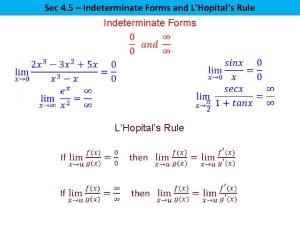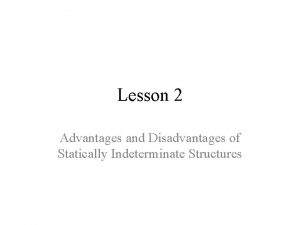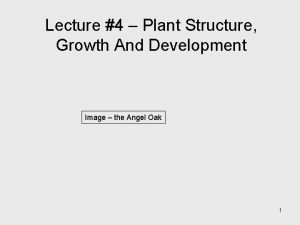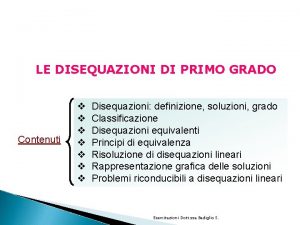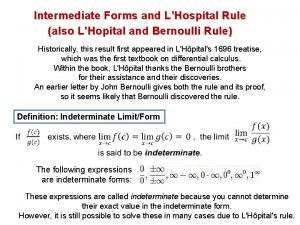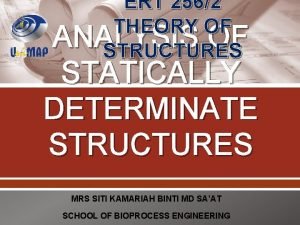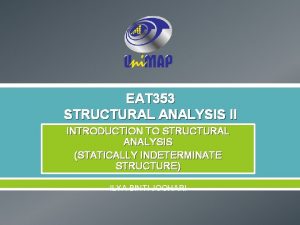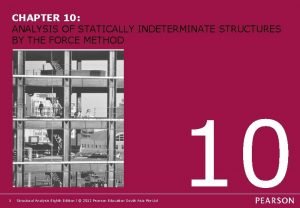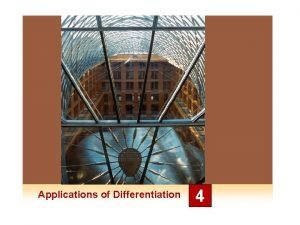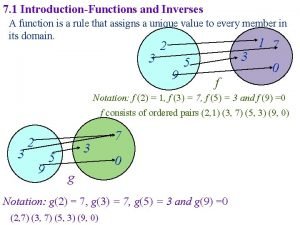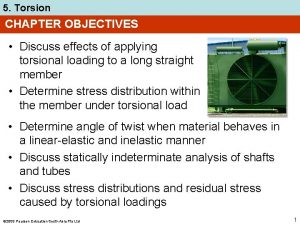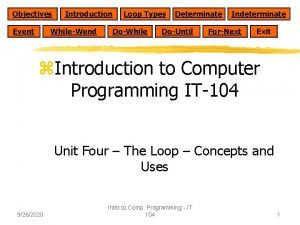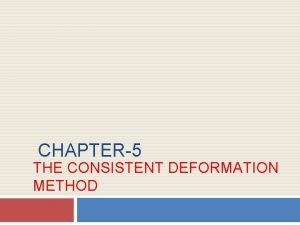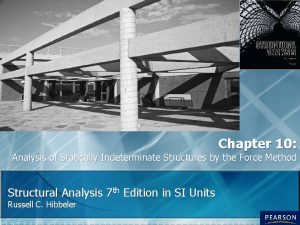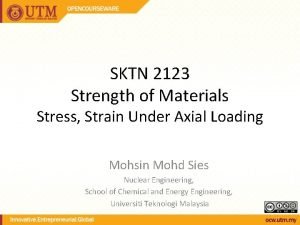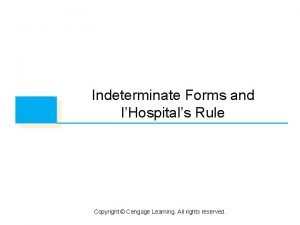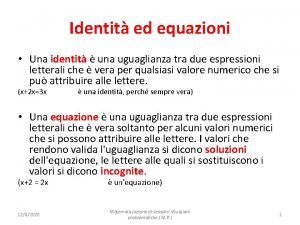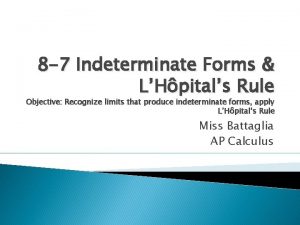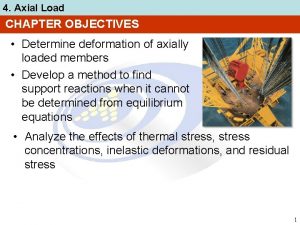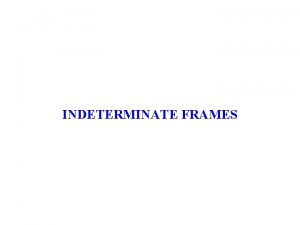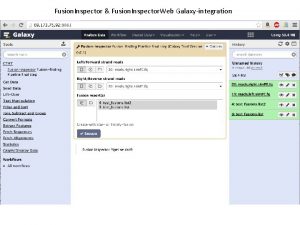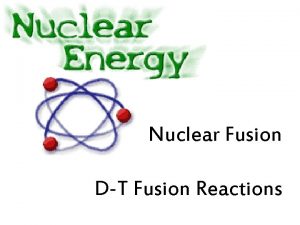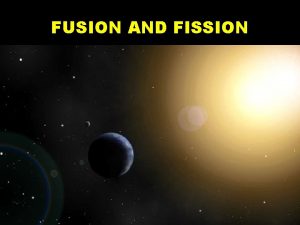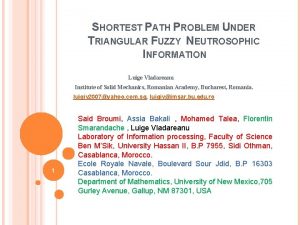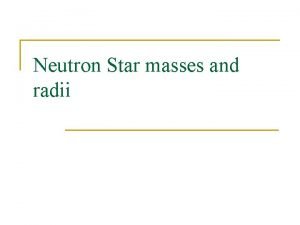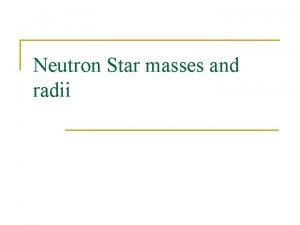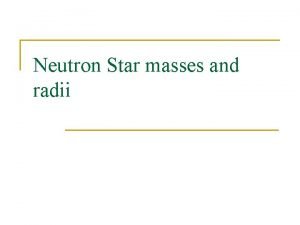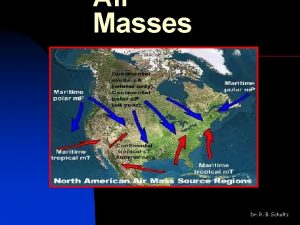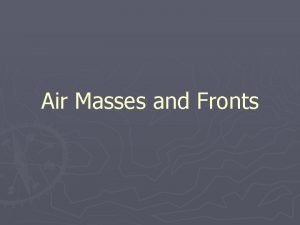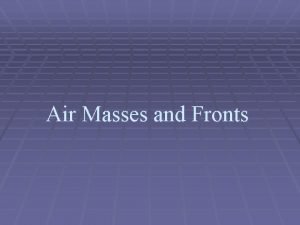Neutrosophic Masses Indeterminate Models Applications to Information Fusion



![Neutrosophic Logic � Neutrosophic Logic (NL) [1] started in 1995 as a generalization of Neutrosophic Logic � Neutrosophic Logic (NL) [1] started in 1995 as a generalization of](https://slidetodoc.com/presentation_image_h2/a57d57d858bd0cb9d969793e8336e2d2/image-4.jpg)


















- Slides: 22

Neutrosophic Masses & Indeterminate Models. Applications to Information Fusion Florentin Smarandache Mathematics Department The University of New Mexico 705 Gurley Ave. , Gallup, NM 87301, USA E-mail: smarand@unm. edu http: //fs. gallup. unm. edu/neutrosophy. htm The 2012 International Conference on Advanced Mechatronic System (ICAMech. S 2012) Tokyo, Japan, 18 -22 September 2012 1

Contents �Introduction �Neutrosophic Logic �Classical Mass (bba) �Neutrosophic Mass (nbba) �Indeterminate Mass (ibba) �Indeterminate Element �Indeterminate Model �Classification of Models �Example of Information Fusion with an Indeterminate Model �Belief, Disbelief, and Uncertainty �Neutrosophic Belief, Neutrosophic Disbelief, and Neutrosophic Undecidability �Neutrosophic Dynamic Fusion �Conclusion 2

Introduction �In this paper we introduce for the first time the notions of indeterminate mass (bba), indeterminate element, indeterminate intersection, and so on. We give an example of neutrosophic dynamic fusion using two classical masses, defined on a determinate frame of discernment, but having indeterminate intersections in the super-power set S (the fusion space). We also adjust several classical fusion rules (PCR 5 and DSm. H) to work for indeterminate intersections instead of empty intersections. 3
![Neutrosophic Logic Neutrosophic Logic NL 1 started in 1995 as a generalization of Neutrosophic Logic � Neutrosophic Logic (NL) [1] started in 1995 as a generalization of](https://slidetodoc.com/presentation_image_h2/a57d57d858bd0cb9d969793e8336e2d2/image-4.jpg)
Neutrosophic Logic � Neutrosophic Logic (NL) [1] started in 1995 as a generalization of the fuzzy logic, especially of the intuitionistic fuzzy logic. A logical proposition P is characterized by three neutrosophic components: � NL(P) =(T, I, F) (3) � where T is the degree of truth, F the degree of falsehood, and I the degree of indeterminacy (or neutral, where the name “neutro-sophic” comes from, i. e. neither truth nor falsehood but in between – or included-middle principle), and with: � T, I, F ] -0, 1+[ (4) � where ]-0, 1+[ is a non-standard interval. � In this paper, for technical proposal, we can reduce this interval to the standard interval [0, 1]. � The main distinction between neutrosophic logic and intuitionistic fuzzy logic (IFL) is that in NL the sum T+I+F of the components, when T, I, and F are crisp numbers, does not need to necessarily be 1 as in IFL, but it can also be less than 1 (for incomplete/missing information), equal to 1 (for complete information), or greater than 1 (for paraconsistent/contradictory information). � The combination of neutrosophic propositions is done using the neutrosophic operators (especially /, / ). 4

Classical Mass (bba) � Let Θ be a frame of discernment, defined as: Θ = {φ1, φ2, . . . , φn}, n ≥ 2 , and its Super-Power Set (or fusion space): SΘ = (Θ, ∪, ∩, C) which means the set Θ closed under union, intersection, and respectively complement. We recall that a classical mass m(. ) is defined as: m : SΘ → [0, 1] such that ∑ m( X ) = 1. X ∈ SΘ 5

Neutrosophic Mass (nbba) �We extend this classical basic belief assignment (mass) m(. ) to a neutrosophic basic belief assignment (nbba) (or neutrosophic mass) mn(. ) in the following way. mn : SΘ → [0, 1]3 with mn(A) = (T(A), I(A), F(A)) where T(A) means the (local) chance that hypothesis A occurs, F(A) means the (local) chance that hypothesis A does not occur (nonchance), while I(A) means the (local) indeterminate chance of A (i. e. knowing neither if A occurs nor if A doesn’t occur), such that: ∑ [T ( X ) + I ( X ) + F ( X )] = 1. X ∈ SΘ 6

Neutrosophic Mass (nbba) - 2 �In a more general way, the above summation can be less than 1 (for incomplete neutrosophic information), equal to 1 (for complete neutrosophic information), or greater than 1 (for paraconsistent/conflicting neutrosophic information). But in this paper we only present the case when the above summation is equal to 1. �Of course, 0 ≤ T ( A), I ( A), F ( A) ≤ 1. 7

Indeterminate Mass (ibba) �A basic belief assignment (or mass) is considered indeterminate if there exist at least an element such that I(A) > 0, i. e. there exists some indeterminacy in the chance of at least an element A for occurring or for not occurring. Therefore, a neutrosophic mass which has at least one element A with I(A) > 0 is an indeterminate mass. �A classical mass m(. ) can be extended under the form of a neutrosophic mass mn’(. ) in the following way: mn': SΘ → [0, 1]3 with mn’(A) = (m(A), 0, 0) but reciprocally it does not work since I(A) has no correspondence in the definition of the classical mass. 8

Indeterminate Mass (ibba) - 2 �We just have T(A) = m(A) and F(A) = m(C(A)), where C(A) is the complement of A. The non-null I(A) can, for example, be roughly approximated by the total ignorance mass m( Θ ), or better by the partial ignorance mass m( ΘI) where ΘI is the union of all singletons that have some non-zero indeterminacy, but these mean less accuracy and less refinement in the fusion. If I(X) = 0 for all X, then the neutrosophic mass is simply reduced to a classical mass. 9

Indeterminate Element �We have two types of elements in the fusion space SΘ, determinate elements (which are well-defined), and indeterminate elements (which are not well-defined; for example: a geographical area whose frontiers are vague; or let’s say in a murder case there are two suspects, John – who is known/determinate element – but he acted together with another man X (since the information source saw John together with an unknown/unidentified person) – therefore X is an indeterminate element). �Herein we gave examples of singletons as indeterminate elements just in the frame of discernment , but indeterminate elements can also result from the combinations (unions, intersections, and/or complements) of determinate elements that form the super-power set SΘ. For example, A and B can be determinate singletons (we call the elements in Θ as singletons), but their intersection A∩B can be an indeterminate (unknown) element, in the sense that we might not know if A∩B= empty or A∩B=nonempty. 10

Indeterminate Element - 2 �Or A can be a determinate element, but its complement C(A) can be indeterminate element (not well-known), and similarly for determinate elements A and B, but their union A∪B might be indeterminate. �Indeterminate elements in SΘ can, of course, result from the combination of indeterminate singletons too. All depends on the problem that is studied. �A frame of discernment which has at least an indeterminate element is called indeterminate frame of discernment. Otherwise, it is called determinate frame of discernment. Similarly we call an indeterminate fusion space ( ) that fusion space which has at least one indeterminate element. Of course an indeterminate frame of discernment spans an indeterminate fusion space. �An indeterminate source of information is a source which provides an indeterminate mass or an indeterminate fusion space. Otherwise it is called a determinate source of information. 11

Indeterminate Model �An indeterminate model is a model whose fusion space is indeterminate, or a mass that characterizes the model is indeterminate. �Such case has not been studied in the information fusion literature so far. 12

Classification of Models �In the classical fusion theories all elements are considered determinate in the Closed World, except in Smets’ Open World where there is some room (i. e. mass assigned to the empty set) for a possible unknown missingleton in the frame of discernment. So, the Open World has a probable indeterminate element, and thus its frame of discernment is indeterminate. While the Closed World frame of discernment is determinate. �In the Closed World in Dezert-Smarandache Theory there are three models classified upon the types of singleton intersections: Shafer’s Model (where all intersections are empty), Hybrid Model (where some intersections are empty, while others are non-empty), and Free Model (where all intersections are non-empty). �We now introduce a fourth category, called Indeterminate Model (where at least one intersection is indeterminate/unknown, and in general at least one element of the fusion space is indeterminate). We do this because in practical problems we don’t always know if an intersection is empty or nonempty. As we still have to solve the problem in the real time, we have to work with what we have, i. e. with indeterminate models. 13

Classification of Models - 2 �The indeterminate intersection cannot be refined (because not knowing if A B is empty or nonempty, we’d get two different refinements: {A, B} when intersection is empty, and {AB, BA, A B} when intersection is nonempty). �The percentage of indeterminacy of a model depends on the number of indeterminate elements and indeterminate masses. �By default: the sources, the masses, the elements, the frames of discernment, the fusion spaces, and the models are supposed determinate. 14

Example of Information Fusion with an Indeterminate Model �Suppose we have two sources, m 1(. ) and m 2(. ), such that: 15

Example of Information Fusion with an Indeterminate Model - 2 16

BELIEF, DISBELIEF, AND UNCERTAINTY 17

NEUTROSOPHIC BELIEF, NEUTROSOPHIC DISBELIEF, AND NEUTROSOPHIC UNDECIDABILITY 18

NEUTROSOPHIC DYNAMIC FUSION �A Neutrosophic Dynamic Fusion is a dynamic fusion where some indeterminacy occurs: with respect to the mass or with respect to some elements. �The solution of the above indeterminate model which has missing information, using the neutrosophic set, is consistent in the classical dynamic fusion in the case we receive part (or total) of the missing information. �In the above example, let’s say we find out later in the fusion process that A∩B = empty. That means that the mass of indeterminacy of A, I(A)=0. 075239, is transferred to A, and the masses of indeterminacy of B (resulted from A∩B only) - i. e. 0. 051428 and 0. 13333 - are transferred to B. �Then one gets: 19

NEUTROSOPHIC DYNAMIC FUSION -2 20

NEUTROSOPHIC DYNAMIC FUSION - 3 � Let’s suppose once more, considering the neutrosophic dynamic fusion, that afterwards we find out that B/C=nonempty. Then, from previous Table the masses of indeterminacies of B, I(B) (0. 065 = 0. 02 + 0. 045, resulted from which was considered indeterminate at the beginning of the neutrosophic dynamic fusion), and that of C, I(C)=0. 065, go now to B/C. Thus, we get: 21

Conclusion �In this paper we introduced for the first time the notions of indeterminate mass (bba), indeterminate element, indeterminate intersection, and so on. We gave an example of neutrosophic dynamic fusion using two classical masses, defined on a determinate frame of discernment, but having indeterminate intersections in the super-power set SΘ (the fusion space). We adjusted several classical fusion rules (PCR 5 and DSm. H) to work for indeterminate intersections instead of empty intersections. �Then we extended the classical Bel(. ), Dis(. ) {also called Dou(. ), i. e Dough} and the uncertainty U(. ) functions to their respectively neutrosophic correspondent functions that use the neutrosophic masses, i. e. to the Neut. Bel(. ), Neut. Dis(. ), Neut. U(. ) and to the undecidability function Neut. Und(. ). We have also introduced the Neutrosophic Global Indeterminacy function, Neut. Glob. Ind(. ), which together with Neut. U(. ) form the Neut. Und(. ) function. 22
 Modals and semi modals difference
Modals and semi modals difference Lhopitals rule
Lhopitals rule Advantages and disadvantages of indeterminate structures
Advantages and disadvantages of indeterminate structures Indeterminate growth
Indeterminate growth Primo principio di equivalenza disequazioni
Primo principio di equivalenza disequazioni What is intermediate form
What is intermediate form Improperly constrained
Improperly constrained Indeterminate structures
Indeterminate structures A building bent deflects in the same way as
A building bent deflects in the same way as Indeterminate growth
Indeterminate growth Advantages of statically indeterminate structures
Advantages of statically indeterminate structures Types of indeterminate forms
Types of indeterminate forms Inverse of ln x
Inverse of ln x Torque
Torque Determinate and indeterminate loop in vb
Determinate and indeterminate loop in vb Method of consistent deformations
Method of consistent deformations Betti theorem
Betti theorem Statically indeterminate axially loaded member
Statically indeterminate axially loaded member Indeterminate product
Indeterminate product Verifica di un equazione
Verifica di un equazione Analysis of statically determinate trusses
Analysis of statically determinate trusses Say again
Say again Axial load formula
Axial load formula

